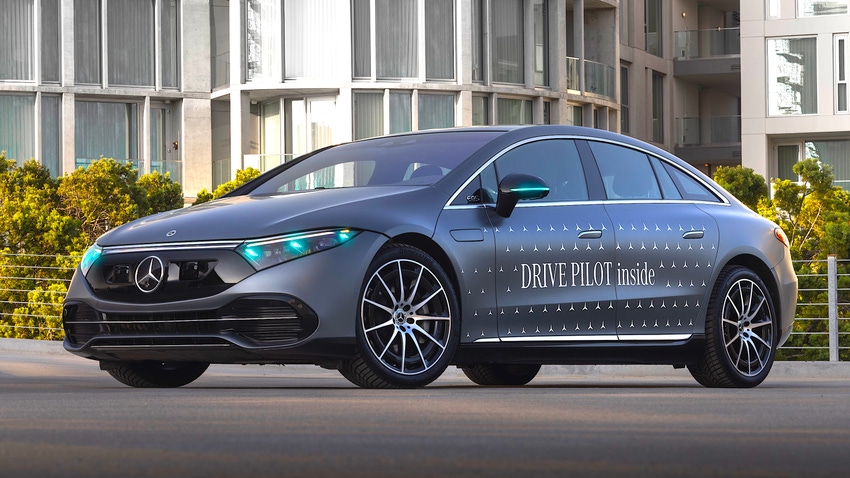Mercedes Employs Turquoise-Colored Lights as Automation Indicators
Mercedes-Benz cars will notify surrounding drivers when the Drive Pilot automated driving function is active.

It has been my experience that computers make rude drivers. Driver assistance and automated driving systems don’t recognize the needs of other drivers, so they don’t slow to allow space for merging traffic to move into the lane from another lane that is ending, for example.
But now Mercedes will provide its drivers the chance to shift blame for any inconsiderate driving by lighting turquoise-colored marker lights when the Drive Pilot system is active. Drive Pilot is the world’s first SAE Level 3-grade driver assistance system to reach customers. The system is on the road in Europe and in the U.S. only in California and Nevada so far.

The outside mirrors feature the colored Drive Pilot lights. MERCEDES-BENZ
The company plans to install the colored lights starting with model year 2026 S-Class and EQS vehicles. As we’ve seen with increasing concern about the freedom that Tesla provides its drivers to abuse the ostensibly Level 2 systems in those cars, there remains very little regulation in the area of driving automation.
Mercedes has asked California and Nevada for permission to apply the turquoise-colored lights for this purpose. This begins the process of trying to establish a standard for such systems to provide notification to other road users that a computer is operating the cars. This is important for police to know that the person who is watching a movie while sitting in the driver’s seat has officially turned over control to the car’s computer.
The notification lights are designed in compliance with SAE J3134 Recommended Practice, with colored lights integrated into the front and rear lights as well as the two outside mirrors. "With the development of automated driving marker lights, Mercedes-Benz is once again setting new industry standards,” crowed Markus Schäfer, Member of the Board of Management of Mercedes-Benz Group AG, Chief Technology Officer, Development and purchasing. “We are the first automaker in the world to receive such approvals in the U.S., specifically in California and Nevada. The more automated driving vehicles populate the road, the more important communication and interaction between the vehicle and the environment become."
Mercedes notes that there is no general framework in the U.S., China or the UN-ECE (United Nations Economic Commission for Europe) for using turquoise lights in production vehicles. But the company says that it is committed to standardizing the color turquoise with the intention to convey the automated driving state, with the goal of fostering understanding and acceptance for this technology. Mercedes says that a future globally harmonized regulation for turquoise marker lights for automated driving will “form the basis for heightened safety for all road users and propelling further technical innovations.”
The company says that it chose the turquoise color because its visibility allows fast detection while differentiating it from existing vehicle lighting and traffic signals such as traffic lights or emergency lighting. The aim is to reduce the potential for confusion with red or blue emergency lights.
Mercedes says that, in studies, both physiological and psychological factors attest to higher values in almost all areas with turquoise rather than with other colors. Turquoise is also described in the industry-recommended practice SAE J3134 "ADS Marker Lamps" for use to display the activation of an automated driving system.
So, it is apparently purely coincidental that color selection coincides with the team color of the Mercedes-AMG Petronas F1 racing team. Mercedes first showcased the potential use of such lights in the 2019 Mercedes-Benz ESF concept car. The company’s engineers worked with compliance managers, data protection experts, and even ethics experts in developing the system.
About the Author(s)
You May Also Like





